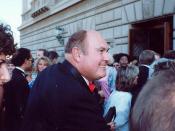River of Confusion Frances Ford Coppola's film Apocalypse Now is a superb rendition of Joseph Conrad's novel, Heart of Darkness. Conrad's novel is based upon a journey of one man into the territory of a dark hell. Coppola uses that base of the novel in his film. The film uses exquisite cinematography and sound to give the viewer the same affect one gets from reading Heart of Darkness.
Although Coppola did not use the same settings as Conrad, the themes are totally the same. The theme of the novel and film is based on Conrad's title, Heart of Darkness. Both are about a journey of one man into the territory of his heart. But what he finds there is darkness. Another thing that is the same is the greed, brutality, and stupidity of the groups of people. This is shown by the Europeans in the novel and the American soldiers in the film.
Also Marlow never is emotionally attached to anyone in the novel except Kurtz. The same goes for Lt. Willard in the film. These are all examples on how Coppola used similar aspects of the novel and put them on screen.
The cinematography in the film really helps the viewer see the theme that Coppola is trying to get across. He uses matched cuts in the beginning of the film. Lt. Willard was lying in his room and the viewer saw the ceiling fan. That image was also used as a rotor blade of a helicopter. The matched cut helps you understand the confusion that Willard is going through. He is not sure if he is dieing in the jungle waiting to be airlifted out or in his hotel room. This scene helps the audience start to understand what soldiers went through in Vietnam.
Throughout the entire film the theme is very evident. Willard just like Marlow is confused and is only really looking for answers about Kurtz. One scene in the film Willard is sitting on the boat and he is reading the file on Kurtz. There is fog all around him and the viewer is only able to see Willard. This basically shows us that he is in a state of confusion in his mind because he is saying that he has killed at least six, but this time it is an American and an officer.
Through the entire film Coppola uses reoccurring images to help get his theme across. There is consistently fog, mist, or some kind of haze. This was showing the viewer that the mind of Willard and the other soldiers were clouded. No one really new what was going on or new why things were happening.
The uses of helicopter blades were also a reoccurring image in the film. They also had the same effect and base meaning as haze did. The blades were used in a variety of a ways. One was the close ups of the blades. They showed a kind of blur on the screen, making the viewer see the confusion of the fast paced war along with the danger. Another way the blades were used is by the images of the dust that was kicked up by them. For instance when the Americans landed in the village full of Vietnamese women and children there was mass confusion when the helicopter touched down. Thus leading to the death of Americans from the bomb thrown by the Vietnamese woman.
This scene also shows the stupidity of the people in the war. After the helicopter is blown up lieutenant colonel Kilgore says " Fucking savages ", even though they are raiding a village that is predominately full of women and children. Also all that Kilgore really wants to do is surf. This coincides with the novel. The Europeans are raping Africa of ivory, killing the natives, and turning the natives into slaves.
During Marlow's journey he longs to find answers about Kurtz, but can't understand anything. When Marlow finally gets to Kurtz's place in Cambodia his questions still are not answered he goes into the jungle to find him. Kurtz's followers capture Marlow and the screen rotates three hundred and sixty degrees. This was well done by Coppola because it shows the audience that know Marlow's world and mind had just been turned upside down. At the moment when the screen rotated you truly got that feeling because you knew Marlow was confused before this and then you were able to see that Kurtz was crazy and lost in his mind.
Another cinematographically excellent scene by Coppola was shown with the use of stone images. Kurtz was talking to Willard and basically trying to brainwash him into thinking what he was saying was the only way. Coppola used a close-up of Kurtz's face as he was talking and than cut to a few images of stone faces and statues. Coppola then went back to a close-up of Kurtz's face and moved the screen across showing a stone wall and then a close-up of Willard's face. This shows the basically shows the audience the way Kurtz is. He is like a stone statue that will never change back to normal and the only way to get rid of a statue is to destroy it. Willard knows this to by showing a stone wall between both his and Kurtz's face. Thus showing that Kurtz's words are not going to get to Willard and he might as well be talking to a wall.
The sound throughout the movie is mostly of helicopters and weapons. Both of those show us that these noises lead to the confusion of the mind. In the opening scene of the film, the shots of Willard and the matched cuts of his ceiling fan and the rotor blade of a helicopter help the audience to believe that that noise reminds the soldiers of horror. But in some parts of the film those noises have a different effect. Lt. Col. Kilgore seems to feel more powerful and almost invincible when the gunfire and rotor blades noises are around him.
Although the novel and the film take place in different eras and different settings, the concept is the same. They are both about confused clouded minds looking for answers, and the greed, stupidity, and brutality of times. But in the end both Willard and Marlow find the answers they need. Kurtz gave them those answers and helps them clear up their minds and hearts. As the film shows the boat with Willard pulling away from the horrific place he was at, the mist and haze is left in the distance. Thus showing the journey of this confusion mind and heart has been left behind and complete.
Works Cited Apocalypse Now. Dir. Frances Ford Coppola. Paramount 1979 Conrad, Joseph. Heart of Darkness. New York: Penguin Group 1995


